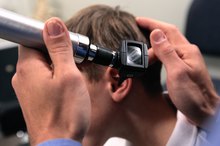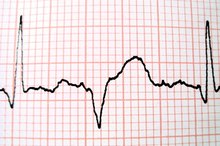How to Find the Pure-tone Average
The pure-tone average is a calculation used routinely by audiologists and occupational health specialists. According to the American Speech-Language-Hearing Association, the pure-tone average (PTA) is used to calculate the degree of hearing loss in decibels 1. Audiologists also calculate the PTA to confirm a patient’s reliability in a hearing test. Dr. Robert Dobie of the National Institute on Deafness and Other Communication Disorders (NIDCD) indicates that the PTA is used to determine the hearing handicap in workman’s compensation cases for occupational hearing loss.
If you are experiencing serious medical symptoms, seek emergency treatment immediately.
Preparation
Place the audiometer on a solid table in a quiet room, plug it into the electrical socket and turn it on.
Sportline Heart Rate Watch Instructions
Learn More
Place your chair in front of the audiometer so that the controls are facing you and can be easily reached.
Position the listener’s chair on the opposite side of the table so that it is facing away from you. This will prevent the listener from seeing you operate the controls.
Parts of the Brain Involved With Hearing
Learn More
Instruct the listener that he will hear a series of tones and he should raise his hand whenever he hears them.
Place the headphones on the listener so that the earphone marked in red is over the right ear and the blue marked earphone is over the left ear.
- Place the audiometer on a solid table in a quiet room, plug it into the electrical socket and turn it on.
- Place your chair in front of the audiometer so that the controls are facing you and can be easily reached.
Pure-tone test
Set the frequency control to 1000 Hz and set the ear to be tested to the right earphone.
Set the intensity level to 50 dB.
Press and hold the presentation (or interrupt) button for one second to give the patient the tone. Wait for the listener to respond.
Lower the intensity by 10 dB if the listener raises his hand signaling that he heard the tone. Then present the softer tone in the manner described in Step 3.
Repeat Step 4 until the listener no longer raises his hand. This means that he did not hear the tone and could represent the threshold or softest level that he can hear.
Note the intensity level on the audiogram.
Raise the intensity by 5 dB, present the louder tone and wait for the listener to respond.
Repeat Step 7 if the listener does not raise his hand. Continue raising the intensity in 5 dB steps until the listener raises his hand signaling that he heard the tone.
Repeat Steps 4 through 8 until the same intensity level is noted in Step 6 two or three times. This is the established threshold or the softest level that the listener can hear that particular tone.
Set the frequency control to 2000 Hz and repeat Steps 2 through 9.
Repeat Steps 2 through 9 for test frequencies 4000 Hz and 500 Hz.
Set the ear to be tested to the left earphone and repeat Step 2 through Step 11.
- Set the frequency control to 1000 Hz and set the ear to be tested to the right earphone.
- Set the intensity level to 50 dB.
- Press and hold the presentation (or interrupt) button for one second to give the patient the tone.
Calculating the pure-tone average
Add up the threshold levels for 500 Hz, 1000 Hz, 2000 Hz, and 4000 Hz for the right ear.
Divide the sum of the values by four. This number is the pure-tone average expressed in decibels.
Repeat Step 1 and Step 2 for the left ear.
Tips
Ask the listener if he has trouble hearing from one ear before placing the headphones on. Test the opposite (better) ear first. If the listener appears to have trouble with the test, recheck his thresholds at 1000 Hz. If the overall test is reliable you should have the same threshold as before.
- Add up the threshold levels for 500 Hz, 1000 Hz, 2000 Hz, and 4000 Hz for the right ear.
- Repeat Step 1 and Step 2 for the left ear.
Related Articles
References
Tips
- Ask the listener if he has trouble hearing from one ear before placing the headphones on. Test the opposite (better) ear first.
- If the listener appears to have trouble with the test, recheck his thresholds at 1000 Hz. If the overall test is reliable you should have the same threshold as before.
Writer Bio
Dwight Romulo Valdez, M.A., FAAA, has been writing health and technology articles since 2008. His articles have appeared on Youandmemagazine.com and Helium.com. Valdez has been in the hearing health care profession since 1983 and currently runs an audiology practice in New Hampshire.








